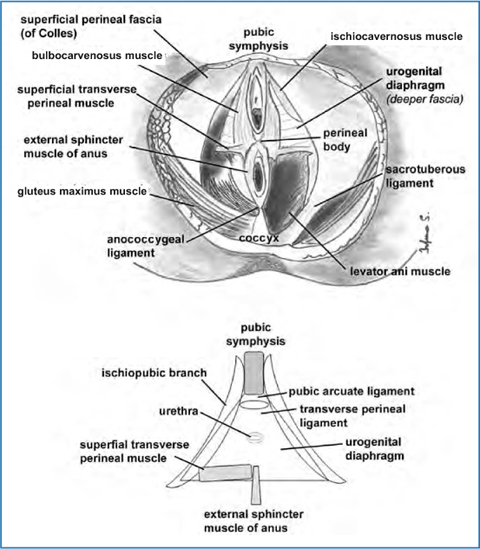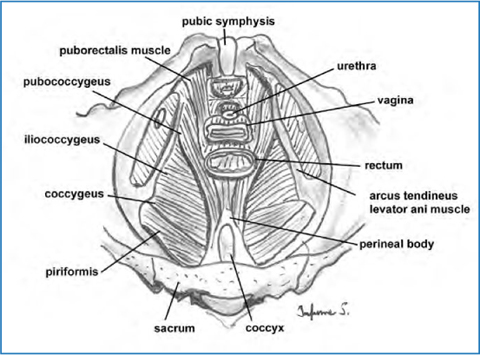Fig. 3.1
The human bony pelvis seen from the front (top) and from below (bottom), showing the bones and main ligament structures of the pelvis supporting the pelvic floor
The main ligamentous structures are the anterior and lateral sacrococcygeal ligaments, the sacrospinous ligament, the sacrotuberous ligament, and the arcuate pubic ligament [2].
3.3 The Musculature, Fasciae, and Aponevrosis
From a surgical point of view, when considering access to the pelvic floor starting from the cutis in a gynecological position (Fig. 3.2, top), the perineal region can be divided in two parts: the superficial and deeper planes. The superficial plane coincides with the fascia of Cruveilhier, which continues with abdominal structures and adheres to the thigh, while the deeper plane coincides with the fascia of Colles [3].


Fig. 3.2
Pelvic floor anatomy in women (top), and the urogenital diaphragm in men (bottom)
The space between the two ischial tuberosities laterally and the pubic symphysis anteriorly is closed by the so-called urogenital diaphragm, which is composed mainly of the deep transverse perineal muscle and forms the anterior urogenital triangle (Figs. 3.1 and 3.2) together with external urethral sphincter, the urethrovaginalis (in woman) and compressor urethrae [4, 5]. This area is covered by the inferior and superficial fascia (Colles) of the urogenital diaphragm. The urogenital diaphragm is perforated, from front to back, in order to permit the passage of the urethra and, in woman, the vagina with its sphincter muscle. Immediately behind the pubic symphysis, the space between the arcuate pubic ligament and the fusion of the deep and superficial fascia of the urogenital diaphragm (the transverse perineal ligament) identifies a tight cleft where it crosses the deep dorsal vein of penis or glans clitoridis (Fig. 3.2, bottom).
The superficial and inferior fascias are fused posteriorly to envelop the superficial transverse perineal muscles, thus contributing to the composition of the perineal body (see below).
Inferiorly to the urogenital diaphragm, and more superficially with respect to the cutaneous plane, two muscles can be identified: the ischiocavernosus and the bulbocavernosus muscles (Fig. 3.2, top). The ischiocavernosus muscles originate from the pubic symphysis, lie parallel to the ischiopubic branches, and are attached to the ischiatic tuberosities. The bulbocavernosus muscles lie medially, and there is a marked difference in these muscles between the two sexes. In women, they surround the vagina between the pubic symphysis and perineal body. In men, they run parallel to each other, separated only from a median raphe.
In the urogenital diaphragm, the anal triangle can be identified [5] (Fig. 3.2, top). The anococcygeal ligament originates from the apex of the coccyx, and it is inserted into the perineal centrum, interrupted by the passage of anal canal with the external anal sphincter muscle (Fig. 3.2, top). The central ligament of perineum or perineal body is histologically composed of smooth and skeletal muscle, as well as collagen and elastic fibers [6]. The perineal body represents the fundamental structure maintaining the anatomical and functional integrity of the pelvic floor, and the point of insertion of the anal sphincter muscle, the transverse superficial perineal muscles (originating from ischiatic tuberosities), and the bulbocavernosus muscle (Fig. 3.2, top).
Once the urogenital diaphragm is removed, the pelvic diaphragm becomes visible. The latter is composed of the ischiococcygeous and levator ani muscles (Fig. 3.3). The ischiococcygeous muscle (or simply coccygeus) originates from the coccyx and sacrum and extends bilaterally extends towards the ischiatic spines and sacrospinous ligaments.


Fig. 3.3
Pelvic floor anatomy seen from cranial axis, showing the pelvic diaphragm and the relation between the muscles and the pelvic organs
The levator ani muscle comprises the pubococcygeus, puborectalis and iliococcygeus muscles (Fig. 3.3) [7, 8]. Moreover, a thickening of the obturator internus, known as the arcus tendineus levator ani muscle, is stretched between the ischial spine to the superior pubic branch. From the arcus tendineus, the iliococcygeus originates, connecting to the coggyx posteriorly and to the perineal body medially, contributing to the creation of the anococcygeal ligament. Some authors divide the pubococcygeus into three regions called: the puboperineus, the pubovaginalis (in women), and the puboanalis [4]. The puboperineus is attached to the perineal body and contributes to its formation; the pubovaginalis and puboanalis muscle bundles fuse with those of the vagina and external anal sphincter, respectively.
Stay updated, free articles. Join our Telegram channel

Full access? Get Clinical Tree






